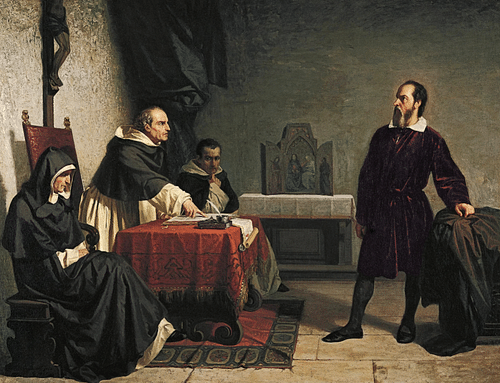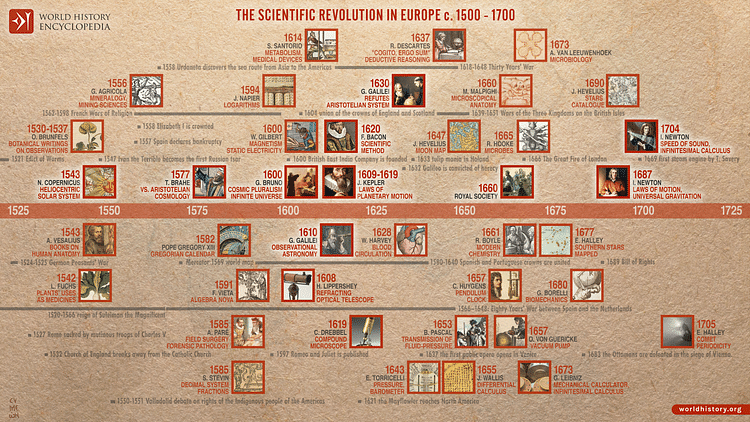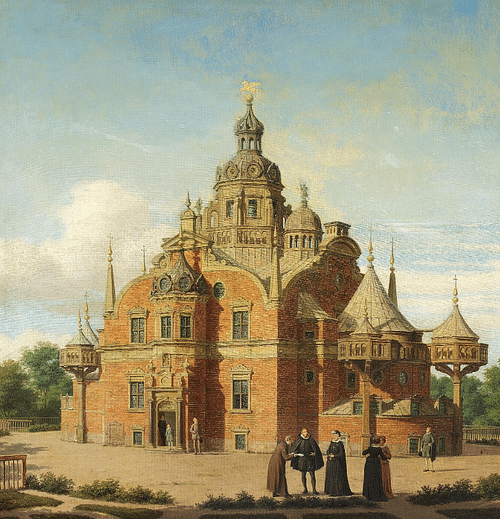The astronomers of the Scientific Revolution rejected long-held theories of ancient thinkers like Claudius Ptolemy and Aristotle and instead set out to systematically observe the heavens in order to create a model of the universe that fit observable facts rather than preconceived theories.
Astronomers like Nicolaus Copernicus, Tycho Brahe, Galileo Galilei, Johannes Hevelius, Edmond Halley, Christiaan Huygens, Johannes Kepler, and Isaac Newton were determined to use observation, scientific instruments, and mathematics to reconcile theory, phenomena, and data and increase our knowledge of the world around us.
Aristotle & Ptolemy v. Scientific Method
Astronomy had interested many ancient thinkers, but two views of the universe dominated and endured right through the Middle Ages. These were the models proposed by Aristotle (384-322 BCE) and Ptolemy (c. 100 to c. 170). Aristotle's model had the planets move in a uniform way through an undefined medium of invisible spheres, always at fixed distances from Earth, the central point. Ptolemy proposed that planets moved within a small circular orbit of their own (epicycle) while still following a larger orbit (deferent) around a fixed central point, the Earth (equant). Perfect circles reflected the perfection of the Creator, and Earth's position at the very centre of it all reflected the belief in humanity's importance. These models survived antiquity and held a seemingly iron grip on the minds of medieval astronomers. The problem, though, was that they left many questions unanswered. The Scientific Revolution was all about questioning age-old beliefs, putting them to the test of observable phenomena, and expressing these findings in the new international language of mathematics. Findings were then shared with and scrutinised by independent thinkers. This idea, or something similar, had first been proposed by Francis Bacon (1561-1626).
In the new scientific method, astronomy led the way over all other fields. The astronomers were on the lookout for new, more satisfactory answers to age-old puzzles. No longer were they satisfied with 'saving the phenomena,' that is the mere measuring of celestial motions, now they began to use their precision scientific instruments to challenge the natural philosophers. The astronomers wanted to prove their own models of just how the universe works.
Copernicus Points the Way
The Polish astronomer Nicolaus Copernicus (1473-1543) knew of Aristotle and Ptolemy's work, and that of later Persian astronomers. He was convinced that none had found the correct answer to explain the things visible in the sky. Copernicus formulated his (not entirely new) theory that the Earth and other planets revolved around the Sun in a heliocentric system and not in a Ptolemaic geocentric system. Copernicus also suggested that the Earth turned on its own axis and orbited the Sun once each year. He proposed, too, that relatively small changes in the angle of the Earth's axis over time explained the precession of the equinoxes – the gradual shifting of the constellations in the night sky over time. Copernicus noted that the observable planets were in the following order from the Sun: Mercury, Venus, Earth, Mars, Jupiter, and Saturn. All of these radical ideas were presented in On the Revolutions of the Heavenly Spheres (1543).

The heliocentric model directly challenged the Aristotelian model that dominated natural philosophy. Further, Copernicus' model went against the traditional view of humanity's central place in the universe as endorsed by the Catholic Church. For the Church, humanity was the focus, indeed, the whole point of God's universe. Copernicus' theory took a while to gain supporters, but in the last quarter of the 16th century, astronomers set about establishing if Copernicus was right. There were also some things left to explain, such as gravity (traditionally explained by Earth being at the universe's centre). By 1616, Copernicus' model was more widely known, and as a result, his work was condemned as heretical by church authorities. Revolutions was listed as a forbidden book. This did not stop astronomers studying the sky; indeed, most were Christians and were not at all interested in challenging Christian doctrine. For many, obtaining the truth about how the universe worked was complimentary to a belief in a divine Creator.
Tycho & Systematic Observation
The Danish nobleman Tycho Brahe (1546-1601) was something of a visionary when it came to astronomy, as he built his own magnificent observatory. Many of his predecessors had only observed what they needed to observe in order to support their particular theoretical model of the universe. Tycho, in contrast, set about creating the most accurate tables of data on the heavens yet compiled. After he had done that, then he would create a theory that best fit the facts. Tycho designed his own instruments, including the new astronomical sextant and a giant mural quadrant.
Tycho was given Hven (Ven) island by King Frederick II of Denmark and Norway (r. 1559-1588), and here he built his Uraniborg observatory from 1576. It was named after Urania, the Greek muse of astronomy. Tycho had already discovered the new star of 1572, a supernova in the Cassiopeia constellation, and this was enough to convince Frederick to invest in astronomy. Star charts were essential for navigation by traders and navies, which meant that rulers began to financially back astronomers.
Tycho's dedication led to several new discoveries, notably the elliptical interplanetary orbit of three comets (1577, 1580, and 1585). Tycho's observations of the Sun proved the inaccuracy of the Julian calendar, which led, in 1582, to the creation of the Gregorian calendar. Tycho also completed a star catalogue, which positioned over 800 stars, the first new catalogue since Ptolemy. In 1603, Tycho's catalogue was made into an atlas of the stars by Johann Bayer (1572-1625).
Armed with all of this data accumulated over decades, Tycho formed his theory on the movement of the planets, published in Of More Recent Phenomena of the Ethereal World (1588). The Tychonic system was a compromise between Ptolemy's geocentric model and Copernicus' heliocentric alternative. Tycho proposed that the Sun and the Moon orbited the Earth while the other planets orbited the Sun. Although this theory was wrong, Tycho's work was the final blow to Ptolemy's model. Tycho's work on the changing supernova and the elliptical orbits of comets did similar damage to Aristotle's model. Clearly, the universe was far from being perfect and eternally stable. For some historians, this was the true beginning of the Scientific Revolution, when incorrect theories were challenged by observation. Tycho's belief that measurements must be continuously taken to improve accuracy became a founding principle of modern science, and it is why many have called Tycho "the true founder of the new astronomy" (Wootton, 456) and called astronomy the first modern science. What was needed next was a high-tech instrument, and in the telescope, the astronomers found the tool that opened up to them whole new worlds.
Galileo's Telescope
The telescope, a simple idea of a convex and concave lens at either end of a tube, caused a revolution in astronomy. It allowed astronomers to see things no human had ever seen before. Although invented around 1608, perhaps by Hans Lippershey (c. 1570 to c. 1619), a Flemish spectacle-maker, it was the Italian astronomer Galileo (1564-1642) who perfected the instrument. Galileo's telescope, his occhiale ('eyeglass'), was 60 cm (24 in) long with an astonishing x33 magnification.
For the first time, the surface of the Moon could be observed and mapped. It was realised that the Moon had valleys and mountains just like Earth. Galileo spotted four satellite moons of Jupiter (further evidence not all heavenly bodies orbited the Earth or the Sun). He studied the phases of Venus and consequently proved that Earth could not be the centre of our galaxy. He observed the sunspots of the Sun, which suggested that it was a revolving sphere. Galileo published his observations in The Starry Messenger (1610). He became as famous as Christopher Columbus (1451-1506), with whom, as the discoverer of a new Cosmos, Galileo was frequently compared. Science, and astronomy, in particular, had become the new frontier of human knowledge. There was a price to pay, though.
Galileo's observations led him to publicly support the Copernicus model, which consequently resulted in him receiving a formal censure from the Catholic Church in 1616. Galileo persisted with his views, which appeared again in his Dialogue on the Two Chief Systems of the World (1632). This was too much for the Church, and Galileo was put on trial for heresy in 1633. Found guilty, Galileo had to stop promoting pro-Copernicus theories, and he was obliged to stay under house arrest in Florence for the rest of his life.

Galileo's contributions are impressive, but perhaps his greatest legacy was his redefinition of what an astronomer should actually do. From time immemorial, astronomers had been mathematicians who meticulously created charts and tables of data. Instead, Galileo shifted the focus of astronomy to direct observation and discovery. In this sense, "Galileo fundamentally changed the notion of what astronomy was about" (Burns, 63). To further these goals, better telescopes were needed to see further since there remained a single unsettling fact. Galileo was convinced that what we could see through a telescope was only a galaxy and not the entire universe. The whole horizon of human intellectual endeavour had shifted towards infinity.
Kepler & Elliptical Orbits
Johannes Kepler (1571-1630) was the official mathematician of Rudolf II, Holy Roman Emperor (r. 1576-1612) in Prague. He inherited the position from Tycho, whose data allowed Kepler to form his celebrated three laws of planetary motion in two works: The New Astronomy (1609) and Harmonies of the World (1619). Here, he demonstrated that the Copernicus model of the universe was the right one, but with the correction that the planets moved around the Sun in elliptical and not circular orbits. He also observed that the speed of each planet varies and that the Sun is responsible for that variation. He was the first to use the term 'satellite', which he applied to the four moons of Jupiter. A believer in cosmic harmony controlled by God, Kepler was the last great astronomer to also practise astrology. Kepler helped all astronomers by perfecting a telescope with two convex lenses, which gave a clearer and more magnified image than previously possible. At last, humanity had an accurate model of our galaxy. Now it was time to observe more closely all that happened within it.
Hevelius, Master of Accuracy
In 1641, the Polish astronomer Johannes Hevelius (1611-1687) established an observatory in Danzig (Gdańsk), funding the project himself. He called it Stellaeburg, where he was assisted by his wife and such future talents as Gottfried Kirsch (1639-1710). Hevelius was known as the "Prussian Lynx" (Vertesi, 213) for his sharp observational skills, and, like Tycho, his activities attracted investment from rulers, in this case, Polish kings and Louis XIV of France (r. 1643-1715), who was eager to improve the navigational charts of his navy.

Hevelius made several important discoveries with his 150-foot (46-metre) long telescope. He observed the first variable star – one that varies in brightness over time – which Hevelius called Mira. He identified four new comets and observed the solar transits of Mercury and Venus. He discovered that the Moon oscillates, and he created a detailed map of its surface, published in Selenographia (1647). Hevelius remained loyal to non-telescopic instruments like his sextant and quadrant when he was measuring the long-term movement of the heavenly bodies. And he was remarkably accurate in doing so. In 1679, when the English astronomer Edmond Halley (1656-1742) visited Stellaeburg, he compared Hevelius' data with his own telescope readings and discovered that it was remarkably accurate. Hevelius' life's work was presented in Prodromus Astronomiae (1690), a comprehensive illustrated catalogue and celestial atlas of over 1,564 stars.
Hevelius is a good example of how international astronomy became a collective endeavour. He was made a Fellow of the Royal Society in London in 1664. He corresponded, too, with astronomers across Europe. This was an important feature of the Scientific Revolution, the belief that data could be made more accurate if collected by different scientists in different places and then compared, especially when observing the same phenomenon at the same time. Data and research were subjected to independent scrutiny. Errors were identified and then corrected, further increasing accuracy.
Discoveries Keep Coming
The Dutchman Christiaan Huygens (1629-1695) made the first working pendulum clock in 1657 and so dramatically increased the accuracy of timekeeping (seconds were still lost per day, but not minutes). This was important for astronomers calculating the movement of heavenly bodies. Huygens was the first to observe the rings of Saturn around 1658 and to clearly observe Titan, one of the planet's moons. Huygens made a massive aerial telescope in 1686, the world's biggest. Dispensing with the tube and keeping only the lenses, Huygens' telescope had a focal length of 210 feet (67 m). Huygens' ideas on aerial telescopes, which greatly increased magnification, were published in Astroscopia Compendiaria (1684). In addition, miniature telescopes were now fitted to existing navigational instruments like the quadrant. Micrometers were added to these telescopic sights to take even more precise measurements, especially of angles.
The Italian astronomer Gian Domenico Cassini (1625-1712) established the Paris Observatory, founded in 1667. He identified the spaces in the rings of Saturn, called today "Cassini's division", and calculated more accurately than ever the distance between the Sun and the Earth (87 million miles). On the other side of the Channel, John Flamsteed (1646-1719) founded the Royal Observatory at Greenwich in 1675. Observatories using telescopes sprang up in unlikely places, such as the Kingdom of Siam (Thailand) in the 1680s and Jaipur in India in the 1720s. More and more scientists worldwide were looking to the skies and doing so in state-sponsored observatories.
Edmond Halley established an observatory on the island of St. Helena in the South Atlantic in 1677. Private companies were growing more interested in astronomy and better navigational charts; Halley was partly funded by the East India Company. From St Helena, Halley was able to create a chart of the stars of the Southern Hemisphere, the first based on observations made via telescope. Halley discovered the acceleration of the Moon and noted the movement of the stars in relation to each other (proper motion). Most famously, Halley identified the comet of 1682 as the same one that had passed by in 1607 and 1531. In 1705, he accurately predicted its return in 1758. Halley was invited to become a member of the prestigious Royal Academy of Sciences in France in 1729, illustrating the increasing internationalisation of astronomy. Perhaps Halley's greatest contribution to astronomy, though, was persuading a colleague to publish his remarkable findings, one Isaac Newton (1642-1727).
Newton & Gravity
Newton invented the reflective telescope in 1668, a device which used a curved mirror to improve the clarity of the image seen and reduce the size of the telescope. Newton discovered gravity, and this explained phenomena that had puzzled all previous astronomers; how the planets rotate, maintain their satellite moons, and move at different speeds depending on their distance from the Sun were all down to this mysterious force. Newton fused mechanical philosophy and mathematics to create three laws of motion in Mathematical Principles of Natural Philosophy (1687):
1. a body at rest or in motion in a straight path will tend to stay in that state,
2. a change of motion in a body varies with the force impressed, and
3. each action has an equal and opposite reaction. (Burns, 218)
Therein was also his universal law of gravity, universal because it applied to everything on Earth and in space:
That between any two bodies in the universe there exists a force directly proportional to the product of the masses of the two bodies and inversely proportional to the square of their distance. (ibid, 245)
Crucially, these laws allowed Newton to make accurate predictions of the effects of gravity. This was a new science, even if some were reluctant to see its truth, notably mechanical philosophers who could not accept that one physical body can affect another body without something physically touching the two. Gravity remained mysterious, since nobody, not even Newton, knew where it came from, why it exists, and who or what ensures its persistence. There was still room for more research and, more importantly for Newton, room for God in his new vision of the Cosmos. Newton's ideas were eventually adopted by the wider scientific community, and there developed a definite movement, known as Newtonianism, which pushed the idea that scientific knowledge should be presented as a series of mathematical laws. Newtonianism gradually spread across Europe to become the dominant approach in universities and amongst intellectuals. Science, of which astronomy was the leading discipline, had finally split from philosophy to pursue its own path of measuring, interpreting, and improving the world in which we live.
Legacy
The astronomers of the Scientific Revolution then transformed the approach to their field of study and made a myriad of discoveries that completely changed our view of space and ourselves. They have not been forgotten. One of the largest craters on the Moon is named after Copernicus. The supernova Tycho observed now bears his name. The European Space Agency landed a craft on Saturn's Titan in 2005; it was named after Huygens. A Polish astronomical satellite sent into orbit in 2014 was named after Hevelius. Halley, of course, has his comet whizzing past every 75 years or so, next to be seen in 2061 in a reminder that the universe is operating on a timescale beyond humanity's comprehension.









